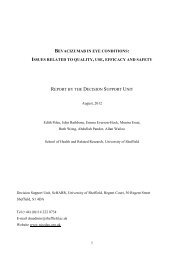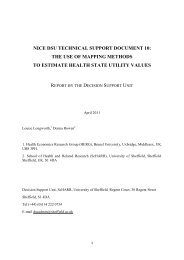5.1. DEFINITION OF TREATMENT EFFECTTreatment effect was defined in several ways with three papers using <strong>the</strong> difference in median timeto-event(e.g median OS), 9,21,27 two using <strong>the</strong> proportional increase in median time-to-event 10,28 and10 using hazard ratios (HR). 11,13-15,17,21,23,24,26,27 One paper defined <strong>the</strong> treatment effect as <strong>the</strong> hazardratio minus unity (HR-1) 11 and ano<strong>the</strong>r examined <strong>the</strong> “percent risk reduction” based on <strong>the</strong> HR. 27 Of<strong>the</strong> remaining papers using <strong>the</strong> HR, all but three 13,21,26 transformed <strong>the</strong> hazard ratio onto a log scalefor <strong>the</strong> linear regression. Five papers defined <strong>the</strong> hazard ratio as <strong>the</strong> ratio <strong>of</strong> <strong>the</strong> median time-to-event<strong>between</strong> <strong>the</strong> trial arms, 11,13,23,24,26 which is consistent with assuming that <strong>the</strong> survival curve isexponential, although no justification was given for this assumption. Three papers estimated <strong>the</strong> HRsdirectly from IPD. 14,15,17 All three used a proportional hazards model to estimate <strong>the</strong> hazard ratios forPFS and OS. One specified that a joint model, based on <strong>the</strong> Hougaard copula, was used to estimatetrial-specific treatment effects on PFS or TTP and survival by using marginal proportional hazardsmodels with normally distributed, random trial–specific treatment effects for <strong>the</strong> TTP and survival. 155.2. REGRESSION METHODSNot all <strong>of</strong> <strong>the</strong> papers reported that <strong>the</strong> regression analyses were weighted according to trialsize. 14,15,21,27 Two <strong>studies</strong> forced <strong>the</strong> intercept <strong>of</strong> <strong>the</strong> regression to zero 11,27 but both considered anddiscounted a non-zero intercept in exploratory analyses. One study explored <strong>the</strong> possibility <strong>of</strong> a nonlinearregression by adding quadratic terms. 11 One study examined residual versus predicted plotsand did diagnostic tests for normality and heteroscedasticity (non-constant error variance) to assessconsistency with <strong>the</strong> assumptions <strong>of</strong> linear regression. 9One study evaluated <strong>the</strong> normality assumption, and presence <strong>of</strong> outliers or influence points usingdiagnostic tests and plots. 13 The <strong>studies</strong> handled trials with more than two arms in a variety <strong>of</strong> ways.Most included multiple comparisons from <strong>the</strong> same trial as multiple points in <strong>the</strong> analysis withoutaccounting for <strong>the</strong> correlations <strong>between</strong> <strong>the</strong>m or <strong>the</strong> double-counting in terms <strong>of</strong> <strong>the</strong> samplesize. 10,21,24,26 One study down-weighted <strong>the</strong> sample size by <strong>the</strong> number <strong>of</strong> trial arms to adjust formultiple comparisons. 23 One study included <strong>the</strong> comparison with <strong>the</strong> greatest treatment effect in <strong>the</strong>analysis and excluded all o<strong>the</strong>rs 9 whilst o<strong>the</strong>rs chose one comparison from each trial ei<strong>the</strong>r atrandom 27 or by using clinical judgement (without regard for <strong>the</strong> size <strong>of</strong> correlation). 13Three <strong>studies</strong> 9,13,26 used multivariate analysis to explore whe<strong>the</strong>r any o<strong>the</strong>r factors were significantpredictors <strong>of</strong> OS. Johnson et al 9 examined patients’ age (trial median), performance status, stage <strong>of</strong>24
disease (for lung cancer), year <strong>of</strong> trial (which was a surrogate <strong>of</strong> improvements in general medicalcare), trial quality, and use <strong>of</strong> rescue (or salvage) treatment. Hotta et al 26 explored <strong>the</strong> following sixadditional factors: year <strong>of</strong> trial initiation; use <strong>of</strong> cisplatin, carboplatin, and old agents; number <strong>of</strong>agents combined (combination <strong>the</strong>rapy versus single agent <strong>the</strong>rapy); number <strong>of</strong> randomized patients;and proportion <strong>of</strong> male patients. Chirila et al 13 examined <strong>the</strong> following factors using covariateanalysis: line <strong>of</strong> <strong>the</strong>rapy, performance status, clinical trial phase, crossover after <strong>progression</strong>, drug<strong>the</strong>rapy, publication year, and median OS for <strong>the</strong> control group. Significant factors were <strong>the</strong>nconsidered in subgroup analyses. They also conducted a subgroup analysis using just those <strong>studies</strong>that reported <strong>the</strong> HR in order to establish whe<strong>the</strong>r <strong>the</strong> ratio <strong>of</strong> medians is a good approximation for<strong>the</strong> HR. Miksad et al 23 refitted <strong>the</strong> analysis with interaction terms for two proxies which aimed tocapture <strong>the</strong> impact <strong>of</strong> treatments given after <strong>the</strong> trial regimen. These were <strong>the</strong> year <strong>of</strong> last patiententry (before or after 1990) and line <strong>of</strong> trial <strong>the</strong>rapy (first versus subsequent-line).Several <strong>studies</strong> used subgroup analysis to assess whe<strong>the</strong>r <strong>the</strong> <strong>relationship</strong> <strong>between</strong> PFS/TTP and OSvaried for trials with particular characteristics. The subgroups considered are summarised in Table 3.Two <strong>studies</strong> analysed whe<strong>the</strong>r <strong>the</strong> <strong>relationship</strong> was different in trials with a reduced risk <strong>of</strong> bias by<strong>examining</strong> factors related to methodological quality. Sherrill et al 11 examined indicators for blindingand <strong>the</strong> availability <strong>of</strong> intention to treat analyses as markers for study quality. Johnson et al 9 assessed<strong>the</strong> quality <strong>of</strong> trials by use <strong>of</strong> <strong>the</strong> Schulz criteria and rated quality according to a 0–7 scale (lowquality





